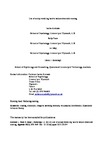Use of a clay modeling task to reduce chocolate craving
| dc.contributor.author | Andrade, J | |
| dc.contributor.author | Pears, S | |
| dc.contributor.author | May, J | |
| dc.contributor.author | Kavanagh, DJ | |
| dc.date.accessioned | 2012-05-17T13:34:36Z | |
| dc.date.available | 2012-05-17T13:34:36Z | |
| dc.date.issued | 2012-06 | |
| dc.identifier.issn | 0195-6663 | |
| dc.identifier.issn | 1095-8304 | |
| dc.identifier.uri | http://hdl.handle.net/10026.1/986 | |
| dc.description.abstract |
Elaborated Intrusion theory (EI theory; Kavanagh, Andrade, & May, 2005) posits two main cognitive components in craving: associative processes that lead to intrusive thoughts about the craved substance or activity, and elaborative processes supporting mental imagery of the substance or activity. We used a novel visuospatial task to test the hypothesis that visual imagery plays a key role in craving. Experiment 1 showed that spending 10 min constructing shapes from modeling clay (plasticine) reduced participants' craving for chocolate compared with spending 10 min 'letting your mind wander'. Increasing the load on verbal working memory using a mental arithmetic task (counting backwards by threes) did not reduce craving further. Experiment 2 compared effects on craving of a simpler verbal task (counting by ones) and clay modeling. Clay modeling reduced overall craving strength and strength of craving imagery, and reduced the frequency of thoughts about chocolate. The results are consistent with EI theory, showing that craving is reduced by loading the visuospatial sketchpad of working memory but not by loading the phonological loop. Clay modeling might be a useful self-help tool to help manage craving for chocolate, snacks and other foods. | |
| dc.format.extent | 955-963 | |
| dc.format.medium | Print-Electronic | |
| dc.language | en | |
| dc.language.iso | eng | |
| dc.publisher | Elsevier BV | |
| dc.subject | Craving | |
| dc.subject | Chocolate | |
| dc.subject | Imagery | |
| dc.subject | Working memory | |
| dc.subject | Visuospatial interference | |
| dc.subject | Elaborated Intrusion theory | |
| dc.title | Use of a clay modeling task to reduce chocolate craving | |
| dc.type | journal-article | |
| dc.type | Article | |
| plymouth.author-url | https://www.ncbi.nlm.nih.gov/pubmed/22369958 | |
| plymouth.issue | 3 | |
| plymouth.volume | 58 | |
| plymouth.publication-status | Published | |
| plymouth.journal | Appetite | |
| dc.identifier.doi | 10.1016/j.appet.2012.02.044 | |
| plymouth.organisational-group | /Plymouth | |
| plymouth.organisational-group | /Plymouth/Admin Group - REF | |
| plymouth.organisational-group | /Plymouth/Admin Group - REF/REF Admin Group - FoH | |
| plymouth.organisational-group | /Plymouth/Faculty of Health | |
| plymouth.organisational-group | /Plymouth/Faculty of Health/School of Psychology | |
| plymouth.organisational-group | /Plymouth/REF 2021 Researchers by UoA | |
| plymouth.organisational-group | /Plymouth/REF 2021 Researchers by UoA/UoA04 Psychology, Psychiatry and Neuroscience | |
| plymouth.organisational-group | /Plymouth/REF 2021 Researchers by UoA/UoA04 Psychology, Psychiatry and Neuroscience/UoA04 REF peer reviewers | |
| plymouth.organisational-group | /Plymouth/Research Groups | |
| plymouth.organisational-group | /Plymouth/Research Groups/Centre for Brain, Cognition and Behaviour (CBCB) | |
| plymouth.organisational-group | /Plymouth/Research Groups/Centre for Brain, Cognition and Behaviour (CBCB)/Behaviour | |
| plymouth.organisational-group | /Plymouth/Research Groups/Centre for Brain, Cognition and Behaviour (CBCB)/Cognition | |
| plymouth.organisational-group | /Plymouth/Research Groups/Institute of Health and Community | |
| plymouth.organisational-group | /Plymouth/Research Groups/Plymouth Institute of Health and Care Research (PIHR) | |
| plymouth.organisational-group | /Plymouth/Users by role | |
| plymouth.organisational-group | /Plymouth/Users by role/Academics | |
| dc.publisher.place | England | |
| dcterms.dateAccepted | 2012-02-18 | |
| dc.identifier.eissn | 1095-8304 | |
| dc.rights.embargoperiod | Not known | |
| rioxxterms.versionofrecord | 10.1016/j.appet.2012.02.044 | |
| rioxxterms.licenseref.uri | http://www.rioxx.net/licenses/all-rights-reserved | |
| rioxxterms.licenseref.startdate | 2012-06 | |
| rioxxterms.type | Journal Article/Review |


